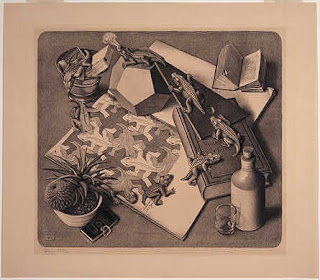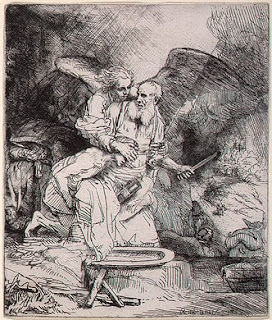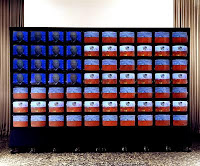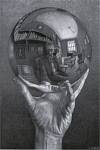
Rembrandt van Rijn, “Abraham’s Sacrifice,” etching and drypoint, Dutch 1655, Baroque Era

M.C. Escher, “Reptiles,” lithograph on paper, Dutch 1943, Modern Period
Art has been around for centuries and dates back to the beginnings of man. Artists come from a variety of backgrounds, races, and ethnicities. Two artists that reign from the Netherlands are Dutch artists Rembrandt van Rijn and M.C. Escher. Although from different centuries in time, both artists found comfort in a naturalistic style. In 1655, during the Dutch Golden Age of the Baroque Era, Rembrandt created “Abraham’s Sacrifice,” an etching and drypoint on paper. In 1943, during the surrealism movement of the Modern Period, Escher created a lithograph called “Reptiles.” The two artists used variations of the same and different subject matter, design elements and principles, and mediums and techniques to develop their unique styles and their masterpieces.
Both works contain subject matter. Subject matter is the objects or events that the work depicts (Getlein, 36). In “Abraham’s Sacrifice,” Rembrandt’s themes are story and history. Artists use stories and histories because they provide the artist with subject matter (62). In Rembrandt’s drawing, he uses emphasis; a principle that draws the viewer’s attention more to one piece of the work than to others (134), to portray the subject matter by creating a contrast in value with his hatching and cross hatching techniques, these will be examined in greater detail in paragraphs to come. The title of the piece, “Abraham’s Sacrifice,” along with the subject suggests that this is a piece of history and illustrates a unique event in the life of Abraham. Escher, however, does not use history and story as a theme in his work. In “Reptiles,” Escher’s themes are invention and fantasy. They come from the minds of the artists. In Escher’s piece, one can tell that the theme is invention and fantasy by the subject. Lizards crawling out of a drawing and the merging back into it can only be created through one’s imagination and fantasy. The artists use themes to portray the subject matter within their pieces. Although the themes are different, each piece is unique and intriguing in its own light.
Both artists employ the visual elements of design as well as the principles of design, both similarly and differently, to create appealing masterpieces. The design element line is present in both works. A line is a path traced by a moving point (82). Rembrandt utilizes implied lines to portray direction of light entering the picture and contour lines can be seen to outline the figures of Abraham, his son Isaac and the angel. Contour lines are the boundaries we perceive of three-dimensional forms (83). In contrast, Escher uses implied lines, figures or objects spaced closely enough that our minds connect them (86), to exhibit motion. A figure is the shape we detach and focus on (89). The lizards themselves act as a “dotted line” that creates a circle as they morph from imagination to reality and back again. Also portrayed in both works is the design element of light. Escher uses a technique called chiaroscuro. It is a technique that employs shades of lights and darks, known as value (92), to record contrasts of light and shadow in the natural world (92). Escher uses this to create shadow and light direction in his work. However, Rembrandt uses hatching and cross hatching to portray the same effect. Hatching is the use of closely spaced parallel lines (93) and cross-hatching is a technique that uses additional lines laid on top of the first set to achieve darker values (93). Through these techniques, Rembrandt is able to produce shadow and light direction similar to that of Escher. The design elements of shape and pattern are present in Escher’s work. Shape is defined as a two-dimensional form that occupies and area with identifiable boundaries (87). In “Reptiles” Escher makes use of implied shape. Notice the shape that the lizards seem to create as the travel in and out of the pattern. Pattern is any decorative, repetitive motif or design (105). The tessellation that the lizards seem to crawl out of is an example of pattern. Both artists employ the design elements of line and light in their masterpieces. Escher also uses pattern and shape. Although both works used the same elements, they produced completely different works that are both visually intriguing and interesting.
Both “Reptiles” and “Abraham’s Sacrifice” use principles of design to generate fascinating works of art. In “Reptiles” Escher uses the design principle of balance. Balance is the equal distribution of visual weight, the apparent heaviness of lightness of the forms arranged in a composition (125). In Escher’s drawing, the plant, the bottle, the open book, and the bucket serve as an implied shape that gives the composition balance. If one of these cornerstones is removed, notice the work becomes unstable. Both artists utilize the design principle of scale, although differently. Scale refers to size in relation to a standard or “normal” size (136). In Escher’s drawing, the lizards in the tessellation are the same size as those that crawl out. In contrast, Rembrandt uses hierarchical scale, the use of scale to indicate relative importance (138). Notice that the angel is drawn above Abraham, who is then above his son Isaac. This causes the viewer to assume that the angel is of a higher importance than Abraham or Isaac. In “Abraham’s Sacrifice” Rembrandt employs the principle of emphasis. Emphasis means that our attention is drawn more certain parts of the composition than to others (134). He emphasizes the focal point in the piece by creating a contrast in value between the scene and the foreground. By using these principles of design, the artists produce works that appeal to art viewers.
The moods of the works clash. Mood can be defined as a conscious state of mind or predominant emotion in art or literature (Merriam-Webster Online). The elements and principles of design that the artists use allow them to express their emotion on the medium. Escher’s 1943 lithograph presents a teasing mood; one that is in some aspect humorous but at the same time sad because the lizards rise up only to return to the same motionless state in the tessellation. In contrast, Rembrandt’s 1655 etching and drypoint radiates with a dramatic mood. This can be seen on the faces of the characters illustrated in the work. Through the creation of the pieces the artists have sent glimpses of their emotions through time with moods that can still be related to centuries and years later.
As important, if not more important than the subject, elements, and design principles used are the mediums and techniques the artists employ. The medium and technique in Escher’s work, lithograph on paper, is a planographic process which means that the printing surface is flat, not raised or depressed (200). Instead it relies on the principle that oil and water do not mix (200). To make a lithograph, artists draw the images on the stone usually with a lithographic crayon or a greasy ink then the stone is treated with an acid solution to fix the drawing to the stone then the non-greasy areas are dampened with water (200). Once that is completed, the stone is inked and the ink sticks to the greasy image areas and is repelled by the water-soaked background areas (200). By identifying the process by which a lithograph is created, the difficulty in creating the range of values, relative lightness or darkness (96), found in the work is apparent. For artists, lithography is the most direct and effortless of the print media (200). However, to achieve the shading effect with a grease pencil or other material, in the detail that is present in this lithograph must have been tedious. Nonetheless, the work represents both imagination and raw talent. In contrast to Escher’s technique of lithography, Rembrandt creates a print on paper, “Abraham’s Sacrifice,” which is a work that utilizes etching and drypoint. Drypoint is a similar technique to engraving except that instead of cutting away the material from the plate, drypoint uses a needle to scratch the plate creating a raised burr, or thin ridge of metal that holds the ink (196). Etching is done with acids, which “eat” lines and depressions into a metal plate where the ground, an acid resistant material made from beeswax, asphalt and other materials, has been etched away by a needle (197). The ink is not the most important aspect; rather, the image created by the etching and drypoint techniques remains the most important. The etching technique seems to have created the contour lines, lines drawn to record boundaries (83) of the middle ground where the scene takes place. By making lower value areas of the work with etching, the acid solution would “eat” these areas into depressions that would create the light appearance. In the work, the drypoint technique seems to be used to create the hatching and crosshatching, closely spaced and parallel lines or a set of closely spaced parallel lines laid on top of one another (93), used to provide the illusion of shadow and implied light. The easiest element to use with drypoint and etching is obviously line which Rembrandt uses very effectively to create this historical scene from a religious background. Even so, Rembrandt and Escher illustrate masterful techniques in the creation of “Abraham’s Sacrifice” and “Reptiles.”
All artworks come from a period and culture. The period of an artwork is defined by the time in history when the work was made. Culture refers to the behavior and belief characteristics of a particular social or ethnic group. These two things greatly influence the style of an artist. Style is a characteristic or multiple characteristics that are identified as constant or recurring in the work of an artist, movement or period (587). Representational art depicts forms in the natural world (587). Naturalistic is descriptive of an approach that portrays the visible works as objective observation and accurate imitations of appearances while being construed as a broader approach, permitting a degree of idealization and embracing a stylistic range across cultures (585). “Abraham’s Sacrifice” was made in 1655 which places it in the Baroque Era (1600s-1700s) (421). Unlike the Renaissance period which stressed calm and reason, Baroque art contains vivid emotion, energy, and movement as well as vibrant colors that differ drastically between colors and value (421). Rembrandt’s naturalistic style along with the techniques and elements of design he used, such as etching and line, allowed him to achieve the fine detail present in his depiction of an epic biblical story and express the emotion typical of the Baroque Era. In contrast, “Reptiles” falls into the Modern Period. The Modern Period is characterized by rapid change and ranges from early 19th century to the middle of the 20th century (1800-1945). Like Rembrandt’s piece, “Reptiles” comes from the Dutch culture. During the 20th century, Dutch painting was strongly influenced by expressionism, characterized by the distortion of visual appearances in order to express psychological or emotional states (583). Escher’s style, like Rembrandt’s, is naturalistic. Also present in many of Escher’s works is trompe l’oeil. This is French for “fool the eye” and is present in representational art that mimics optical experience so closely that it may be mistaken for reality (30). In “Reptiles” we see this trickery where the lizards wretch themselves from the drawing and then return. It can be said that his style was strongly influenced by the movement during the time; surrealism, which grew out of Dada and appreciated the logic of dreams, the mystery of the unconscious, and the lure of the bizarre, the irrational, the incongruous, and the marvelous (529). Typical of this movement and Escher’s works are impossible perspectives, fantastic metamorphoses and general eye-trickery. This work, as well as others from Escher and members of this surrealism movement, are interesting and allow for the liberation of the mind and extract the imaginative powers of the unconscious and add to his unique naturalistic surrealist style.
Great artists such as Rembrandt van Rijn and M.C. Escher put vast amounts of time and effort into their creations. Everything affects the overall composition from the subject matter selected to be displayed to the design elements, design principles, mediums, techniques, and styles used to bring the composition to its end. Period, culture, and movements also contribute to the overall genetics of the masterpieces. When artists consider all of these essentials and arrange them in a way such as these artists have, masterpieces are created. Rembrandt’s “Abraham Sacrifice” and Escher’s “Reptiles” represent masterful compositions that utilize all the fundamentals necessary to have timeless and appealing pieces. In choosing these two artworks, I have learned a lot about art that I would not have known otherwise. I can now begin to examine others and analyze them from a knowledgeable light.
Sources:
Getlein, Mark. Living with Art, 8th Edition. McGraw-Hill. 2008
Merriam Webster Online Dictionary. 2007-2008 Merriam Webster Incorporated. http://www.merriam-webster.com/dictionary/mood







































